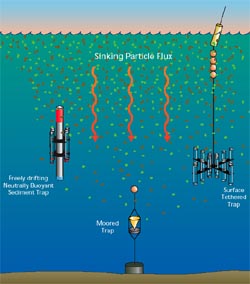Marine snow – though it sounds like magical ice snowflakes drifting through the ocean is actually made up of many more particles than its land counterpart. When things happen in the ocean such as dying/decomposing animals particles of these events break up, and slowly drift down to the sea floor. These biological components and additional sediment/inorganic particles are marine snow. As they slowly fall through the water, smaller particles can aggregate into larger, fluffy “snowflakes.” The slow, but constant fall of these particles provides an influx of nutrients to the organisms that live at the bottom of the ocean. Whatever isn’t consumed becomes part of the “ooze” that blankets the floor. (NOAA)
Today, of course, we understand the function of marine snow. It helps to provide nutrients to organisms living in the deep ocean. However, this wasn’t always the case. For a long time, scientists were puzzled; how did organisms living on the seafloor get food in the first place? And, once they knew of these particles, how did they actually get there? Essentially, researchers saw that these particles are originally eaten by zooplankton, and packaged in a coating which preserves them on their way down. But the coating itself still isn’t enough to create the “snow” in the amounts researchers were observing. It’s likely that the fecal pellets combine with other aggregates and larger particles, and that these all float down together. This would make sense, since many of the “snowflakes” are fibrous and sticky.
Because marine snow is constantly falling, there is a thick layer of it on the seafloor. Just like sediments, digging a few layers into this is representative of a large expanse of time. This is extremely useful evolutionarily, as it makes it easy to track developments of microorganisms. Further, unlike many microorganisms which can evolve relatively quickly, these organisms operate on longer time scales because nutrients are so sparse.
Sediment Traps are used to sample the marine snow (See Figure 1). Marine sediment at the bottom is sampled using a moored trap, and tethered traps are used to catch falling snow. The sediment traps are relatively simple, consisting of a funnel that catches the snow, and a jar to collect the snow. This is attached to a buoy, or anchored so that it can be found again. The data from these traps tells researchers how fast snow is falling through the column, what it is made of, and how fast events at the surface will be felt by the deeper ocean. The downside of the traps is that they catch snow falling vertically, if the trap gets shifted horizontal in storm events, it won’t be able to accurately capture falling snow. (WHOI)

Figure 1: Sediment Traps used to sample marine snow. (WHOI)
Madeline Kollegger and Taylore Grunert
Works Cited
US Department of Commerce, National Oceanic and Atmospheric Administration. (2013, June 01). What is marine snow? Retrieved March 25, 2017, from http://oceanservice.noaa.gov/facts/marinesnow.html
Honjo, Susumu. “Marine Snow and Fecal Pellets”, Oceanus Magazine, vol. 40, no. 2, 1997. Retrieved March 28, 2017 from
https://www.whoi.edu/oceanus/feature/marine-snow-and-fecal-pellets
Marlow, Jeffrey. “The Slow LIfe Movement: A Microbial Perspective of the Subsurface Biosphere”. Discover, March 23, 2017. Web. Retrieved March 28, 2017 from http://blogs.discovermagazine.com/the-extremo-files/2017/03/23/501/#.WNUWmhLytE4